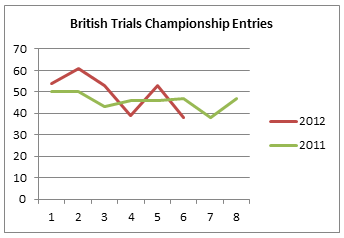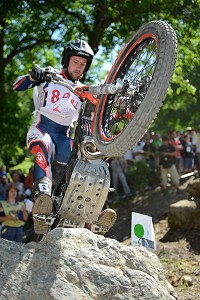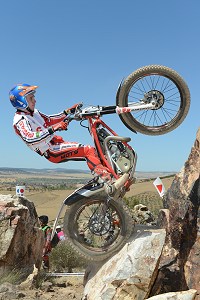 So it’s been decided. The 2013 FIM Trial World Championship will be run under no-stop rules and, as expected, the debate that started when the ACU decided to make the 2012 British Championship no-stop rolls on and on. Is no-stop the answer? We don’t believe so, but let’s leave personal opinion aside for a moment and look at the facts…
So it’s been decided. The 2013 FIM Trial World Championship will be run under no-stop rules and, as expected, the debate that started when the ACU decided to make the 2012 British Championship no-stop rolls on and on. Is no-stop the answer? We don’t believe so, but let’s leave personal opinion aside for a moment and look at the facts…
With the British Championship being no-stop for 2012, this gives us a benchmark and some good, solid figures to work from. We’ve taken a look at the entries for the British Championship in 2011 and compared them to 2012 to see what, if any, impact the no-stop ruling has made. In calculating this data we’ve looked at overall numbers of entries. Anyone listed as “Retired” in the results was included in the numbers as, to retire, they must first have started so were in attendance. The overall figures include entries in both Championship and Expert classes. For 2011 we totalled Expert A plus Expert B. In 2012 there was just one Expert class so we used that figure.

From the graph above it does look like 2012 was a healthier year in terms of entries on the whole. The two rounds where entries dropped below 40 were those held in Devon and South Wales. This ties in with our earlier statement that COST, not rules is the major contributory factor in dropping attendances.
 So, we hear you say, if cost is the factor then why were numbers so high at the opening round in Scotland? Firstly, the round organised by Lochaber has always been a popular event. Secondly there was the “novelty” factor. People will have wanted to find out how they fared under the new rules and thirdly, and most importantly, it was held on the 15th of April – just three weeks before the Scottish Six Days Trial. What better way for those riding the SSDT to get in a good practice session on SSDT territory all above board and legal?
So, we hear you say, if cost is the factor then why were numbers so high at the opening round in Scotland? Firstly, the round organised by Lochaber has always been a popular event. Secondly there was the “novelty” factor. People will have wanted to find out how they fared under the new rules and thirdly, and most importantly, it was held on the 15th of April – just three weeks before the Scottish Six Days Trial. What better way for those riding the SSDT to get in a good practice session on SSDT territory all above board and legal?
Going back to the figures, let’s look at the overall average number of riders. In 2011 the average works out at 45.9 riders per round. In 2012 it is 49.7 riders per round. The introduction of no-stop rules increased championship entries by an additional 3.8 riders. Not exactly mind-blowing figures and doesn’t factor in riders who may have moved up from Youth Championships and would have ridden regardless, however it is at least an increase, but at what cost?
We’ve been told that bike sales are in decline and that the no-stop move was to encourage more entries and subsequently increase the sale of bikes. Who’s going to buy those bikes? The guys and girls already riding the championship? No. They’ve already got bikes. Spectators? The no-stop rules will encourage spectators to take up the sport and go out and buy a bike. Maybe, but we’d have to ask “What spectators?” We only attended two British Championship Trials last year and in terms of Spectators both were very poorly attended. We even left the second one early because it just wasn’t entertaining to watch, let alone try and take dynamic photos of and subsequent reports from numerous sources have said exactly the same. No-stop just isn't spectator friendly. The British Championship is supposed to be a showcase of the best of our riders impressing and wowing. That’s what people want to see. That’s what will make little Johnny pester his Dad to buy him a bike. We also think that the marketing and promotion for the British Championship is atrocious which certainly doesn’t help with attendance figures, but that’s another story, for another day.
 So, if we take what we’ve learned from the British Championship and apply it at a world level, can we expect rider numbers to increase by a similar factor? Entries at the last day of the 2012 World Championship here in the UK, across the three classes, were 49 so a similar number to the British Championship. Will that now increase to a massive 52 because of no-stop rules? Of course not. It will continue to decline because the rules are not the problem. The problem is COST.
So, if we take what we’ve learned from the British Championship and apply it at a world level, can we expect rider numbers to increase by a similar factor? Entries at the last day of the 2012 World Championship here in the UK, across the three classes, were 49 so a similar number to the British Championship. Will that now increase to a massive 52 because of no-stop rules? Of course not. It will continue to decline because the rules are not the problem. The problem is COST.
There was one quick, easy way that the FIM and manufacturers could have done more to increase entries. You may have seen on Trials Central recently that Jim Lampkin launched his Trials Pro service. A service where rider’s bikes were shipped centrally to the world rounds and where they had the use of workshop facilities whilst there. The cost of that transport and facilities would be shared between a number of riders rather than each having to bear the burden individually. A simple idea, yet a fantastic way to reduce overall costs. If the FIM and manufacturers actually thought about it and had the insight to say “You know what Jim, that is a brilliant idea. Let us subsidise it so you can reduce the cost per rider even further.” THAT is how to increase entries. It’s really not rocket science to realise the cheaper it is, the more you will attract.
So what are the ramifications for the World Championship? This decision is unpopular with the riders. Anyone who follows the top riders on Twitter over the past couple of days will know that only too well! There has even been some mention of riders quitting Trials altogether. How can that be positive for the sport? Over and above that, no-stop is just not as spectator friendly as stop-allowed. Spectators want to be wowed. They come to see the huge steps, massive splats and big leaps. If they get bored they go home and they don’t come back. That then affects organisers who have massive up-front costs to host a world round. Those organisers understandably need to get those costs back. Whether it’s through gate money or via funding from local tourist/authority resources as happens in some parts of Europe, they must cover their costs. If the spectators don’t turn up then there is no gate money and no funding so the sport loses organisers and, as importantly, their venues, which are becoming harder and harder to find.
We’re well aware that this is a debate that will run and run, but the long and the short of it is the rules are not the problem and changing them will not make that problem go away. Helping the riders to reduce their costs and make riding the World Championship more affordable would be a far more positive step in attracting more riders than forcing no-stop rules on an entry that don’t want it with no impact to spectator numbers who’d be just as “wowed” and impressed as they’ve been in previous years.
